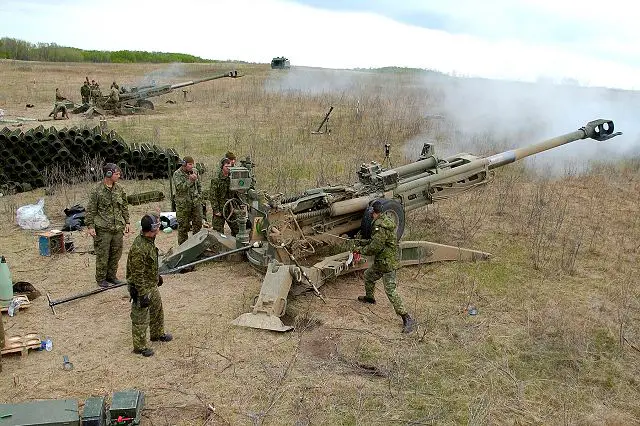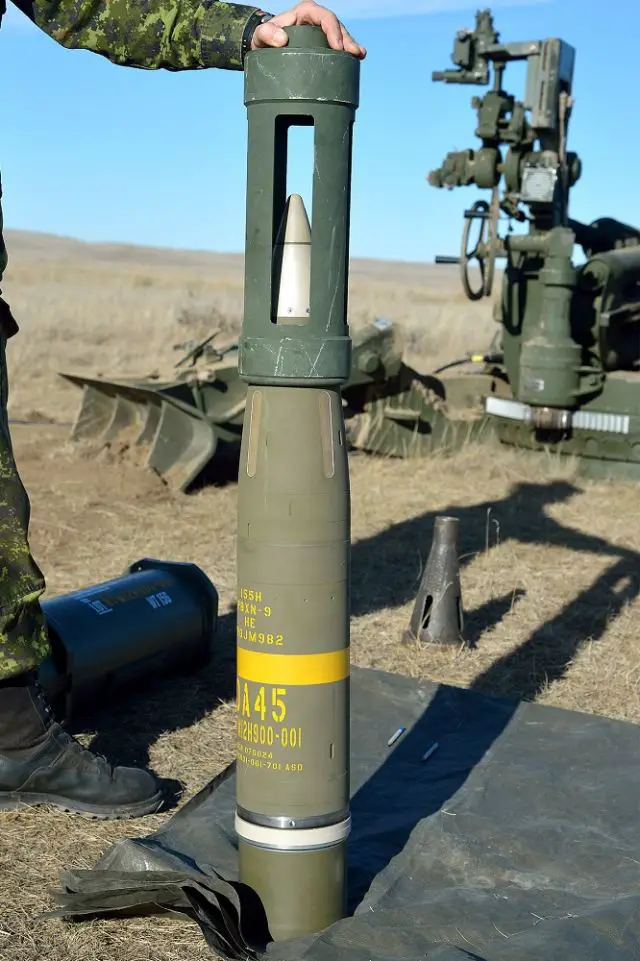| a | |||
Military Defense Industry Technology - Excalibur 155mm artillery shell |
|||
| Thursday, November 27, 2014 07:53 AM | |||
| Canadian army artillery successfully tests Excalibur 155mm GPS guided artillery shell. | |||
It was a ground-breaking day for the Royal Canadian Artillery (RCA) when
they successfully test-fired a Global Positioning System (GPS) -guided
155 mm artillery shell. The trial of the newest generation of Excalibur
proved the mettle of a shell that is unmatched for precision, range and
accuracy. Already used effectively to save lives and reduce collateral
damage in Afghanistan, the first firing of Excalibur shells in Canada
took place at Defence Research and Development Canada’s (DRDC’s)
Suffield, Alberta Experimental Proving Ground. The Excalibur round exceeded
all expectations. |
|||
 Gunners fire two M-777 155 mm guns from an artillery position including Battery X, troop 3 during Exercise MAPLE GUARDIAN in Wainwright, Alberta |
|||
| |
|||
“The
test firing was considered a success and the Excalibur round will very
likely be accepted into service in the Canadian Armed Forces,” said
Captain Greg Keach, Director Land Requirements 2-2-2 and Project Director,
Lightweight Towed Howitzer Project. “The Excalibur test rounds were
amazingly accurate,” said Capt Keach. “We shot three from
an M777
lightweight Howitzer. Two of them struck and functioned on
a 5 by 5 metre target with unbelievable accuracy, well within the range
of acceptable and planned accuracy for the round. Both of them were textbook.”
Another important feature that was trialed was the digitization of fire orders. The Excalibur “smart” rounds, unlike conventional rounds, need data and, therefore, the fire order method required an update. “Fire orders are still primarily sent by voice. A lot of our allies are moving to full digitization of the fire order. It’s better than sending data by voice because it helps remove any potential human errors,” said Capt Keach. As well, the data can be encrypted for additional operational security. Senior Army staff from across Canada attended the trial, including the Colonel Commandant of The Royal Regiment of Canadian Artillery, Brigadier-General (Retired) James Selbie, who described this trial as “a momentous occasion in Canadian artillery history.” “The synergy for this test was considerable,” says Capt Keach. “Not only did we shoot the Excalibur rounds to validate the system, but this trial also included DRDC–Suffield who took the opportunity for testing a special bunker, the RCAS took pictures and video footage for training materials related to precision munitions, and scientists from DRDC–Valcartier’s Munitions Experimental Test Centre (METC) employed high-speed images and radar tracking to verify the accuracy. We definitely maximized the training value of this trial for several agencies.” Excalibur shells – or “bullets” in artillery slang – can be precisely guided to targets up to more than 35 km away and yet have the built-in technology and fail-safe mechanisms to automatically switch off and not detonate if there is a failure that causes them to land outside their designated target zone. “Conventional artillery is known as an area weapon. Generally, you can’t shoot one bullet to take out a car or the corner of a building where an insurgent sniper may be firing. It’s known as an area weapon because you fire a number of projectiles to neutralize the target area,” says Capt Keach. “This bullet, Excalibur, is different. It allows us the opportunity – an extra tool in the toolbox, if you will – to pinpoint the sniper or vehicle. It has great range and accuracy which is what we need on the modern battlefield,” he says. |
|||
 A close-up look at an Excalibur GPS-guided artillery shell. |
|||
| Developed over a 10-year period by Raytheon Company, Excalibur’s final testing was completed in 2007 and used with success in Afghanistan and Iraq. Although more expensive than regular artillery rounds, one Excalibur can neutralize a target whereas conventional artillery would require dozens of rounds before having a direct hit on the target. “The Excalibur artillery shell represents a precision capability that enables the Canadian Army to bring to bear scalable, reliable and judicious effects at the right place and time to achieve mission objectives in the conduct of full spectrum operations,” says Lieutenant-Colonel Stewart Taylor, Commanding Officer 1st Regiment Royal Canadian Horse Artillery. The addition of the Excalibur round to the Canadian inventory provides commanders with an optimized inventory of lethal weapons that mitigates against the unintended consequences of collateral damage to civilian risk objects. A clear example of the value of an Excalibur round is in urban warfare where the potential is extreme for soldier and civilian deaths along with devastating property damage when conventional artillery fire is used. Excalibur shells can be fired within close proximity of friendly troops, a critical concern when infantry comes under sniper fire in urban areas. In Afghanistan from January to November 2009, Lieutenant-Colonel Robert Dunn, Director of Land Requirements 2, was responsible for all operations that were taking place in Kandahar Province at that time. One day, a difficult scenario played out against an urban backdrop. A Canadian artillery crew was supporting Canadian and Allied troops when a pair of insurgent snipers on opposite corners of a rooftop pinned them down. The GPS coordinates were communicated to the crew and, according to LCol Dunn, “The Canadians fired and we neutralized the threat in a timely and an accurate fashion with minimal collateral damage. This specific event was noteworthy because it was probably the only time we fired two Excalibur rounds simultaneously into the same target.” “Knowing that we saved probably 100 lives out there, that really stands out in my mind. We fired a couple of other times after that but that one stands out because we saved so many that day,” he said. Excalibur, the legendary sword of King Arthur, was said to have magic and was symbolic of the responsible use of power. “Any sufficiently advanced technology is indistinguishable from magic,” according to novelist Arthur C. Clarke. Following this logic, magic is the ancestor of today’s applied science. Applied science, in the form of GPS technology, is the magic behind the precision, range and accuracy of the Excalibur artillery round. |
|||
Canadian army artillery successfully tests Excalibur 155mm GPS guided artillery shell 2711141
- Posted On














